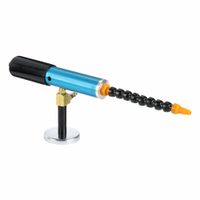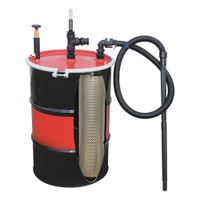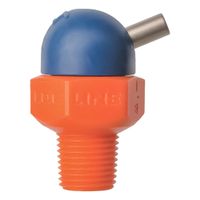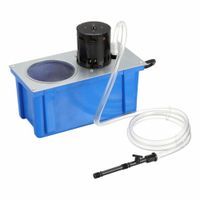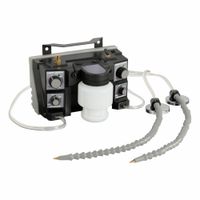Call +(254) 703 030 000 / 751 483 999 / 721 704 777
.....Read More
Frequently Asked Questions
What is the purpose of a machining coolant system?
A machining coolant system serves several critical purposes in manufacturing. Firstly, it dissipates heat generated during the cutting process. Without proper cooling, excessive heat can lead to rapid tool wear, workpiece distortion, and poor surface finish. Secondly, coolant lubricates the cutting interface, reducing friction between the tool and the workpiece. This lubrication helps to minimize tool wear, improve chip evacuation, and reduce power consumption. Thirdly, the coolant flushes away chips from the cutting zone, preventing chip re-cutting and ensuring a clear path for the tool. This also helps in maintaining a cleaner work environment. Lastly, some coolants provide corrosion protection to both the workpiece and the machine tools, extending their lifespan. By effectively managing heat, lubrication, and chip removal, a well-designed coolant system significantly improves machining efficiency, tool life, and the quality of the final product.
How does a mist coolant system work?
A mist coolant system works by atomizing coolant fluid into a fine mist and delivering it to the cutting zone during machining operations. This process involves a reservoir that holds the coolant, a pump to draw the fluid, and a nozzle that mixes the coolant with compressed air to create the mist. The primary benefit of a mist system is its efficient cooling and lubrication.
Unlike flood coolant systems that drench the workpiece, mist systems apply a precise amount of coolant directly where it's needed, minimizing waste and mess. The fine droplets evaporate quickly upon contact with the hot cutting tool and workpiece, carrying away heat through the latent heat of vaporization. This rapid cooling prevents excessive heat buildup, which can lead to tool wear, material deformation, and poor surface finish.
In addition to cooling, the mist also provides lubrication, reducing friction between the tool and the workpiece. This improved lubrication can extend tool life, allow for higher cutting speeds, and produce smoother cuts. Mist coolant systems are often preferred for materials that are sensitive to thermal shock or for operations where flood coolant is impractical due to cleanliness concerns or specific material properties. They are particularly effective in operations like drilling, milling, and grinding.
What are the benefits of using a flood coolant system?
Using a flood coolant system offers several significant benefits in machining operations. Primarily, it excels at heat dissipation, continuously flushing away the intense heat generated during cutting. This prevents thermal deformation of the workpiece and extends tool life by maintaining a consistent, lower tool tip temperature, reducing wear and tear.
Secondly, flood coolant effectively lubricates the cutting interface. This lubrication minimizes friction between the tool and the workpiece, leading to smoother cuts, reduced power consumption, and improved surface finish on the final product.
Thirdly, the flood action efficiently clears chips and swarf from the cutting zone. This prevents re-cutting of chips, which can damage the tool or workpiece, and ensures a cleaner, more stable cutting environment. This also contributes to better chip evacuation, which is crucial for preventing chip buildup and potential tool breakage.
Finally, flood coolant systems can reduce the risk of work hardening in certain materials, which can occur due to excessive heat. By maintaining a cooler temperature, the material's properties are better preserved, leading to more consistent and predictable machining results. These combined benefits contribute to higher productivity, better part quality, and lower overall manufacturing costs.
How does minimum-quantity lubrication differ from other coolant systems?
Minimum-quantity lubrication (MQL), also known as near-dry machining, is a sustainable alternative to traditional flood cooling in machining processes. Unlike conventional coolant systems that drench the workpiece and cutting tool in a large volume of fluid, MQL applies a minuscule amount of lubricant, typically an oil-air mixture, directly to the cutting zone.
The primary difference lies in the volume and application method of the coolant. Traditional systems use a large volume of water-based coolants to dissipate heat and flush chips, leading to significant fluid consumption, waste disposal issues, and potential health hazards from mist. MQL, on the other hand, focuses on lubricating the tool-chip interface, reducing friction and heat generation at the source. This targeted application significantly minimizes coolant usage, often by more than 90%, and eliminates the need for extensive filtration and disposal infrastructure.
Furthermore, MQL systems often use biodegradable oils, further enhancing their environmental benefits compared to water-based coolants that may contain harmful additives. While MQL might not be suitable for all machining operations, especially those requiring aggressive cooling or chip evacuation, its advantages in terms of reduced cost, environmental impact, and improved worker safety make it a increasingly preferred choice for many modern manufacturing applications.
What is the function of a cold-air coolant system?
A cold-air coolant system, often found in various applications from automotive engines to industrial machinery and HVAC systems, is designed to regulate temperature by dissipating excess heat. Its primary function is to maintain optimal operating temperatures for components that generate significant heat during operation, preventing overheating and potential damage.
The system typically works by circulating a coolant—a liquid or gas—through a closed loop. As the coolant passes through hot areas, it absorbs heat. This heated coolant then flows to a heat exchanger (like a radiator or condenser), where the absorbed heat is transferred to a cooler medium, often ambient air, or sometimes water. Fans are commonly used to pull or push air across the heat exchanger, enhancing the heat transfer process. Once the heat is dissipated, the cooled coolant is recirculated back into the system to absorb more heat, thus continuously cooling the components.
The benefits of a cold-air coolant system include improved efficiency, extended component lifespan, and enhanced safety by preventing thermal runaway.
How do coolant mixers ensure accurate ratios?
Coolant mixers ensure accurate ratios through a combination of precision engineering and controlled delivery systems. Many modern mixers utilize venturi pumps, which create a vacuum to draw in concentrated coolant and mix it with water at a precise ratio based on the nozzle size and water pressure.
Other methods include positive displacement pumps, which deliver a fixed volume of concentrate with each stroke, ensuring a consistent ratio regardless of fluctuations in water pressure. Some advanced systems incorporate sensors and electronic controls to continuously monitor the mixture and adjust the flow rates of water and concentrate as needed, providing real-time accuracy. These systems often feature user-adjustable settings, allowing operators to fine-tune the coolant concentration for different applications, while built-in safeguards prevent over-concentration or dilution. Regular calibration and maintenance are also crucial to maintaining the long-term accuracy of these mixing systems.
What role do coolant nozzles play in machining?
Coolant nozzles play a crucial role in machining by delivering cutting fluid directly to the cutting zone. This fluid serves several important functions. Primarily, it cools the cutting tool and workpiece, preventing overheating that can lead to tool wear, workpiece distortion, and poor surface finish. Secondly, it lubricates the interface between the tool and workpiece, reducing friction and extending tool life. Thirdly, the coolant helps to flush away chips from the cutting area, preventing chip re-cutting and improving chip evacuation, which is vital for maintaining a clear cutting path and preventing damage to the workpiece or tool. The precise direction and flow of the coolant from the nozzles are critical for maximizing these benefits, ensuring efficient machining operations and high-quality results.
Why are flexible coolant shields important?
Flexible coolant shields are important because they provide a versatile and effective way to direct coolant precisely where it's needed during machining operations. Unlike rigid or fixed coolant nozzles, flexible shields can be easily adjusted and repositioned to target specific areas, such as the cutting edge of a tool or the workpiece itself. This precise delivery helps to optimize cooling and lubrication, which in turn leads to several benefits.
Firstly, improved cooling extends tool life by preventing overheating and thermal shock, which can cause premature wear and failure. Secondly, effective lubrication reduces friction between the tool and workpiece, leading to better surface finishes and reduced power consumption. Thirdly, flexible shields help to clear chips and debris from the cutting zone, preventing re-cutting and improving chip evacuation, which further contributes to tool life and surface quality. Finally, the flexibility of these shields allows them to be adapted to a wide range of machining operations and tool geometries, making them a valuable asset in many manufacturing environments.
How do oil skimmers and coalescers work in coolant systems?
Please specify the topic you would like me to elaborate on.
What is the importance of coolant system filtration?
Coolant system filtration is crucial for maintaining the efficiency and longevity of an engine's cooling system. Over time, rust, scale, contaminants, and debris can accumulate in the coolant, leading to abrasive wear on water pump seals and other components. These particles can also restrict coolant flow, reduce heat transfer efficiency, and potentially cause overheating. Effective filtration removes these harmful particulates, preventing premature wear, extending the life of cooling system components, and ensuring optimal engine operating temperatures. This translates to improved fuel economy, reduced maintenance costs, and a more reliable vehicle or machinery.
